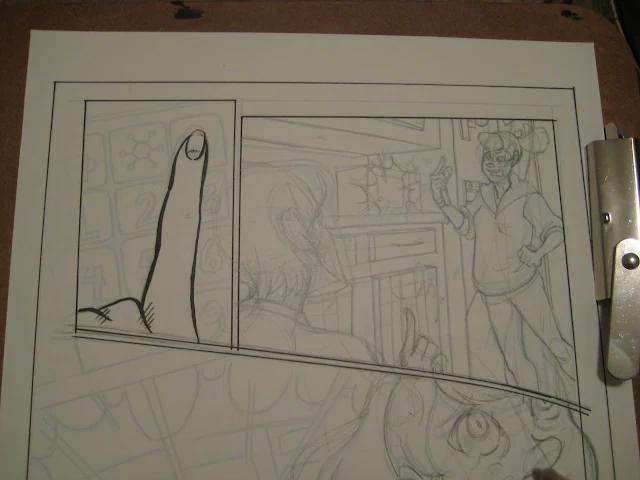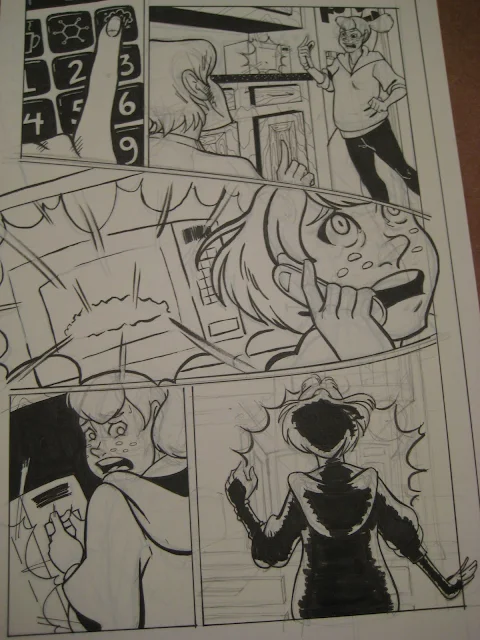Inking Process
This is my usual inking setup and my usual inking supplies. I like to use Multiliners because they're portable and make for quick clean up- there's no waiting for heavy acrylic ink to dry before I start to make corrections. I do use liquid correction inks, although I do not recommend the ink in the white bottle at the bottom- it is way too thin to effectively cover anything up. When inking, it's really important to work in a room with good light- natural lighting is probably best. Unfortunately, I like to work at night and my apartment has TERRIBLE natural light, so I'm forced to work in the unnatural yellow flourescent of my overhead lights. I do have a couple natural light lamps, but the shadows they cast are harder on my eyes than the ugly yellow lighting.
Mixed in with my inking supplies are my usual drafting supplies- erasers and pencils. Since I'm using a different process to achieve a finished comic, a lot of correction happens as I'm inking. I'm perfectly fine with this.
I really enjoy working with a brush pen, and use it whenever the subject is large enough to merit it. In this case, the finger was inked with the brush pen. Technical pens naturally give a fairly stiff line, which can kill the appeal and dynamism in a comic.
For areas that I intend to go over with the white gel pen, I just go ahead and black them out entirely, and then draw over it when it's dried. Gel pens don't like to work on wet ink.
For the numbers, its easier just to work around the white areas. I carefully outline the numbers in Multiliner, then fill in with the brush pen.
White gel-pen detail.
While inking, my brush pen ran out. This happens fairly often, as I use the brushpen as my main source of spot blacks. I have several refills on hand. These brushes are very easy to refill as they have a cartridge system. You just pull off the old one, and push on the new one until it snaps into place. Test your brush on a scrap piece of paper to ensure proper ink flow.
You shouldn't feel constrained to work in one orientation, move the paper for the angle that best suits your wrist.
Adding highlights to the black buttons with a white gel pen.
Faces are the hardest for me to ink, since if you mess up even a little, the whole face is messed up. I carefully ink my smaller faces with Multiliners.
I messed up on the collar. Instead of breaking out the slow drying white ink, I rely on my white gel-pen for a fast fix.
For the middle panel, I went ahead and inked everything with the black brush pen. Her hand is a bit small, I'm going to resize it in Photoshop when I do the lettering. The brushpen does a fun, dynamic line that's perfect for these sorts of panels.
When inking the background, I rely on my ruler to ensure a neat, straight edge.
Basically finished, just needs a few corrections. This is how MY scanner scans it. All the blacks seem gray. A quick and dirty fix is to simply open it in Photoshop, copy the background layer, set the copy to Multiply, and then adjust the opacity until you reach the black richness you desire.
Mixed in with my inking supplies are my usual drafting supplies- erasers and pencils. Since I'm using a different process to achieve a finished comic, a lot of correction happens as I'm inking. I'm perfectly fine with this.
I really enjoy working with a brush pen, and use it whenever the subject is large enough to merit it. In this case, the finger was inked with the brush pen. Technical pens naturally give a fairly stiff line, which can kill the appeal and dynamism in a comic.
For areas that I intend to go over with the white gel pen, I just go ahead and black them out entirely, and then draw over it when it's dried. Gel pens don't like to work on wet ink.
For the numbers, its easier just to work around the white areas. I carefully outline the numbers in Multiliner, then fill in with the brush pen.
White gel-pen detail.
While inking, my brush pen ran out. This happens fairly often, as I use the brushpen as my main source of spot blacks. I have several refills on hand. These brushes are very easy to refill as they have a cartridge system. You just pull off the old one, and push on the new one until it snaps into place. Test your brush on a scrap piece of paper to ensure proper ink flow.
You shouldn't feel constrained to work in one orientation, move the paper for the angle that best suits your wrist.
Adding highlights to the black buttons with a white gel pen.
Faces are the hardest for me to ink, since if you mess up even a little, the whole face is messed up. I carefully ink my smaller faces with Multiliners.
I messed up on the collar. Instead of breaking out the slow drying white ink, I rely on my white gel-pen for a fast fix.
For the middle panel, I went ahead and inked everything with the black brush pen. Her hand is a bit small, I'm going to resize it in Photoshop when I do the lettering. The brushpen does a fun, dynamic line that's perfect for these sorts of panels.
When inking the background, I rely on my ruler to ensure a neat, straight edge.
Basically finished, just needs a few corrections. This is how MY scanner scans it. All the blacks seem gray. A quick and dirty fix is to simply open it in Photoshop, copy the background layer, set the copy to Multiply, and then adjust the opacity until you reach the black richness you desire.



























thank you
ReplyDelete